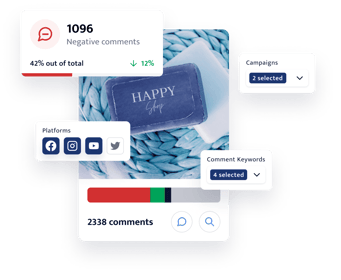
Facebook Sentiment Analysis: Use Cases & How to Do It For Free
Looking to understand if Facebook comments about your brand are positive, negative, or neutral? With sentiment analysis, you can interpret emotions (positive, negative, and neutral) in your social media comments. This will allow you to identify an overall opinion about your campaign, a specific ad, your product, or your brand.
Summary:
- What is sentiment analysis?
- Facebook Sentiment Analysis: Use Cases
a. Monitoring Brand Reputation
b. Campaign Optimization
c. Product Feedback & Improvement
d. Preventing PR Crises
e. Improving Customer Service & Experience - How to Do Sentiment Analysis on Facebook!
What is sentiment analysis?
Sentiment analysis is the machine learning process of analyzing textual content to evaluate if an opinion is positive, negative, or neutral.
Sentiment analysis, frequently referred to as opinion mining as well, is a popular tool and a field of study in multiple research areas, such as computational linguistics, data science, social sciences, and market research, among others. You can read more about it in our article on the topic here!
Facebook Sentiment Analysis: Use Cases
To perform sentiment analysis on Facebook comments, it’s important to understand that social media language is very nuanced, and the use of emojis, sarcasm, and specific language models (e.g., memes) needs to be considered. You can utilize Facebook Sentiment Analysis to solve many problems and bring additional insights into a broad audience’s opinions:
a) Monitoring Brand Reputation
Keeping a pulse on brand reputation is the most common way to use sentiment analysis on Facebook. Sentiment analysis is the best way to assess brand reputation and get real insights to inform marketing decisions since it allows brands to:
- Track how customers are feeling towards the brand over time
- Understand trends and patterns
- Pinpoint outliers and changes in sentiment
BrandBastion's Platform Example: sentiment timeline to track how customers are feeling towards a brand over time
b) Campaign Optimization
Running successful ad campaigns on Facebook becomes increasingly challenging every day. You think you have all the attributes aligned perfectly, but your audience might disagree. Doing a quantitative assessment by measuring reach and frequency or conversions is only a part of the campaign success formula.
Combining it with a qualitative metric like audience sentiment gives you a real overview of your ad campaign performance. Imagine if you are missing out on conversions because the ad's effectiveness is hampered by negative sentiment. What can you do? Listen and analyze.
BrandBastion's Platform Example:
How you can use Facebook Sentiment Analysis to understand which ad creatives are resonating with your audience
It’s essential for a business to know how consumers feel about their brand. Word of mouth can destroy a business just as well as it can skyrocket its growth. Getting thousands of comments across social campaigns is great, but it spells trouble if all these comments are complaints. If this happens in your ad comments, you end up paying to show people negative comments about your business. One way to mitigate this is to respond to public comments, we have an article on the topic here.
With Facebook Sentiment Analysis, you can understand if your campaigns are resonating with your audience and if you need to adjust your creative or messaging by listening to what people are commenting across ads. Tracking sentiment across your ads gives you insights into how your audience is responding to your content.BrandBastion's Platform Example:
How you can use Facebook Sentiment Analysis to understand which campaigns are resonating with your audience
Analyzing people’s opinions on your ads can give you valuable insights into their perception of your products and services, as well as your targeted message. It can also give you an indication of the direction that your next campaigns and even business decisions should follow. Essentially, sentiment analysis is a direct reflection of the effectiveness of your advertising.
c) Product Feedback & Improvement
Social media conversations are one of the best ways to understand product pain points and USPs (Unique Selling Propositions). By filtering by positive and negative comments, you can already uncover many insights into your product, but to focus on the specific comments that talk about your product, you can use keyword filtering paired with sentiment analysis.
Example to find product pain points
Sentiment: Negative
Keywords: dislike, I wish, hate, despise, detest, loathe, expensive, payment, I need, issue, error, difficult, hard, strenuous, demanding, tough, arduous, terrible, awful, dreadful, atrocious
Example to find Unique Selling Propositions
Sentiment: Positive Keywords: like, love, best, favorite, most-liked, favoured, dearest, special, preferred, choice, ideal, fav, beloved
Example to Find What Customers Want/Need
Sentiment: Positive, Negative or Neutral Keywords: wish, want, prefer, bring, need, desire, must, crave, please, require, demand, longing, long for, essential
d) Preventing PR Crises
By using sentiment analysis, you can keep an eye on sentiment changes that can turn into PR Crises and get ahead of them before they escalate. By leveraging sentiment insights, you can respond to issues before they blow up by getting notified when there's a peak in negative comments, for example.
Make sure to quickly tweak your messaging to ensure that you're putting out the right content at the right times and in the right places. This will help you avoid potential social media blowbacks and PR crises.
e) Improving Customer Service & Experience
You can use sentiment analysis to understand where you need to improve (by reading negative comments) and where you are doing a good job (by examining positive feedback). You can then use these insights to guide your strategy to improve customer experience.
Not only that, but you can easily prioritize customer interactions based on their sentiment: if you receive a customer complaint with negative sentiment, then you can prioritize that customer and try to fix their issue as soon as possible. On the other hand, a positive conversation can be handled with less urgency.
3. How to Do Sentiment Analysis on Facebook
BrandBastion’s sentiment analysis tool allows you to analyze your paid campaigns’ sentiment for free for 30 days on the platform and enables you to learn what your customers are saying across thousands of comments. BrandBastion's highly accurate sentiment classification automatically rates every comment as positive, negative, neutral, or user tag only. We have built proprietary technology using classifiers trained on vast amounts of social media native content to consider context, tone of voice, and emojis, among many other factors.
You will be able to access everything you need to uncover an insightful Facebook Sentiment Analysis, including:
- The volume of comments your paid campaigns are receiving (and filter comments by campaign!)
- The overall sentiment your audience had towards the campaign, based on the comments
- Compare the sentiment in different campaigns or Facebook Posts
- Top ads with the most negative and most positive comments
- Sentiment timeline
- Sentiment word cloud
- And much more!
Start to get real-time insights into sentiment across all ads (and organic posts too!).
